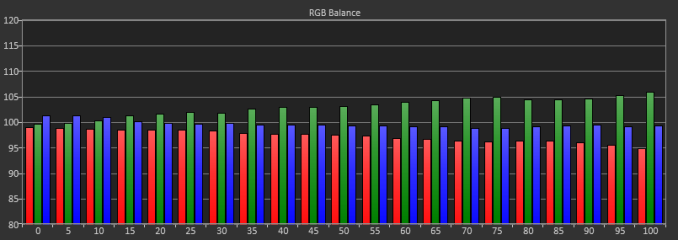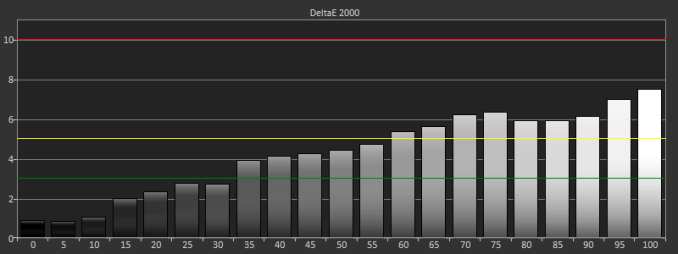Dell U3014 LCD Review
by Chris Heinonen on April 15, 2013 2:00 PM ESTThe U3014 ships with a copy of Dell UltraSharp Color Calibration Solution on the CD but doesn’t include the necessary hardware. For this you actually need to buy an i1Display Pro meter, though you can order it off Amazon or anywhere else and not just directly from Dell. One thing to note is that you need to use the retail i1DisplayPro meter and not the OEM version, as they have a different hardware ID and companies have to buy the licenses for each type separately from X-Rite. For 99% of you this won’t be an issue, but it meant my i1DisplayPro didn’t work as it’s an OEM one that some calibration software requires, and so Dell provided me with a brand new one. This is really an X-Rite issue as they added this restrictive licensing that didn’t exist on their old hardware, but it’s something to be aware of.
Using the Color Calibration Solution is really quite easy. You hook up the i1DisplayPro meter, choose your targets, and let it work. You can set up two custom settings in the CAL1 and CAL2 settings on the monitor, and you can choose from common colorspaces or a custom one. This makes it very easy to set up an sRGB and AdobeRGB calibration, Day and Night calibrations, or any other combination. One thing I wish Dell did let you do was rename them in the display, as Day and Night would be easier to remember than CAL1 and CAL2.
Dell also needs to provide some post-calibration measurements showing the difference from before and after. LGs calibration package does this, but the Dell software just finishes and installs the profile with no numbers, charts, or side-by-side examples to show you what it did. One would assume it gets very close to the target, but you really have no idea at all unless you measure with another software package. That’s mighty inconvenient to have to do.
The main issue I have with the Dell software, which we will see shortly, is that it only supports the i1DisplayPro. Being a colorimeter and not a spectrometer, the i1DisplayPro is very good at reading levels of light but can be confused by irregular wavelengths of light. Since the U3014 uses a brand new G-B LED array that has different wavelengths than most monitors, that means the i1DisplayPro is likely to interpret data from it incorrectly unless it has a custom response table built for each individual meter. With the U3014 aiming directly at the upper-end of the marketplace, it needs to include support for spectrometers like the i1Pro as well to do a better job calibrating it.
To show the difference this makes, I made three sets of measurements after the Dell software finished its calibration. The first set is using the i1DisplayPro that the software uses to do the calibration. The second is using an i1Pro meter, which is a spectrometer. The third is using a C6 colorimeter, which is basically a slightly customized i1DisplayPro, but which has been profiled in CalMAN using the i1Pro so it knows how to read the light spectrum from the U3014.
First up, let’s look at the grayscale numbers. Using the i1DisplayPro, we see there is a heavy green shift, with a bit of blue at times, and red is really low. However, if we switch to the i1Pro or the profiled C6, we see that red and green are high and blue is low. Our average CCT switches from 6826K, a blue tint, to 6325K, a reddish tint. If you’re comparing results and it’s not a very dark screen (below 10 cd/m2), the spectrometer is going to be correct, not the colorimeter. Here we see that the Dell software might think it’s getting a better result than it is, because the i1DisplayPro can’t read the light output properly.

Looking at the Grayscale dE2000 data, we actually see a huge error when only using the i1DisplayPro, with an average dE of 4.3 whereas the C6 and i1Pro see errors of 1.99 and 2.12 respectively. I lean to the C6 numbers over the i1Pro as it can read 20% and below much better, which means that data is going to be more accurate. We still see that we get totally different results from the same screen using the different meters, and we get worse data from the i1DisplayPro itself, which I didn’t expect to see.

This carries over into the Gretag Macbeth charts as well, where we see a much higher average dE2000 (2.96) with the i1DisplayPro than we do with the C6 (1.59) or the i1Pro (1.68). This is mostly grayscale error, but skin tones and oranges in particular are also poor. It might be that those wavelengths are the ones the i1DisplayPro has trouble reading correctly, and so its picking up less red than it should. This would account for almost all of these issues, but it still shows the problems with only using a single colorimeter that hasn’t been profiled for the display it is being used on. These problems only grow as you use custom backlights that have a new spectral signature.

In the end, the Dell software gets you closer than the default, and if you have an i1DisplayPro that you can use I’d go ahead and use it. However, if you have access to something like an i1Pro or other spectrometer, you could use ArgyllCMS and one of the free front ends like dispcalGUI to get better results because it can read the light correctly. If Dell can add support for the i1Pro or another spectrometer, or even better allow you to profile the i1DisplayPro off an i1Pro, then their software would be very nice to use. Considering its free, this might seem like a lot of complaints, but I wouldn’t want someone to buy the U3014, use the software and their suggested meter, and think they have a perfectly calibrated display when we can see that isn’t actually the case.
















84 Comments
View All Comments
zer0future - Monday, April 15, 2013 - link
Would you guys be able to review the new monitors from Monoprice.com? Here is the link for anyone interested.http://www.monoprice.com/products/subdepartment.as...
The 27 inch model apparently uses the same panel as the apple cinema display. These prices are also quite competitive so they have me interested.
cheinonen - Tuesday, April 16, 2013 - link
I'm talking to them, though I personally think the 30" would make for a more interesting review as we've covered a lot of the 27" IPS panels now. Also, if you look back at the two LG 29EA93 reviews that I did, you can see that the panel only makes up a small part of the performance of a display. The corresponding electronics are a huge factor in performance, so I don't recommend just looking at the panel to determine the performance.Trefugl - Tuesday, April 16, 2013 - link
It is great to hear that you are in talks with Monoprice! I would be grateful for a review of either model, but would be more interested in the one with an OSD. I'm concerned with having a wide gamut screen that has no sRGB mode or color correction on board, tho the potentially reduced input lag of not having processing is alluring as well.cheinonen - Thursday, April 18, 2013 - link
I don't believe any of the Monoprice displays are wide gamut, only sRGB gamut. It looks like the 30" one has a 10-bit panel, but that's certainly 8-bit with AFRC, which might give you better gradients, but won't give you a wider gamut.B3an - Tuesday, April 16, 2013 - link
Chris, i'd really appreciate it if you could help me as i'm thinking of buying this monitor. Do you have any idea at all if the i1Display 2 will calibrate this monitor well? It comes with Eye-One Match 3 software.And what software would you recommend most for calibration? dispcalGUI?
cheinonen - Tuesday, April 16, 2013 - link
Personally, I wouldn't use an i1Display2 anymore for color accuracy. With the design of the i1Display2, and the fact that they haven't been made for a year or two now, the filters degrade over time so that anything it is reading now may or may not be accurate at all. It can read light levels correctly, so white and black light output, but not the colors of light. I have a pair of them here and testing them now compared to the i1Pro, I see dE2000 errors > 10 in the grayscale using it. The standard calibrated modes are going to likely be more accurate.I like dispcalGUI. I haven't used the most recent version, but I've been using it for a long time now and they do a great job adding more and more features to it.
von Krupp - Tuesday, April 16, 2013 - link
You know what's missing from this monitor? Support for 5.1 output like its out-going predecessor. I make great use of that feature on my U2711, and not having it here is a major deal-breaker. I run my Xbox 360 to the monitor via HDMI and pipe the audio out through the analogue 5.1 jacks to Logitech X-530s. I would not be able to do that with these new monitors.I might be a hold-out, but one of the primary selling points for me on the U3011 and U2711 was the fact that, for a PC monitor, they offered a diverse array connectivity. You can do HDMI, composite, component, DVI, VGA, and DP all on the same monitor. You can also, as mentioned, earlier, output to analogue 5.1 surround. This monitor is not worth the $1500 asking price in light of this "streamlining" of features. If I'm paying top-dollar for a monitor whose predecessor I already own, I want it to have all of the capabilities of that predecessor and then some. $1500 for what is only a good panel and LED back-lighting is a raw deal no matter how you slice it.
jamyryals - Tuesday, April 16, 2013 - link
Chris, my coworker has a Nixeus 27inch monitor attached to a 2012 MBP. His Nixeus has the same problem of not activating after sleep sometimes as well. A simple power cycle gets it going again for him too. Just another data point to indicate where that particular problem may be.l_d_allan - Tuesday, April 16, 2013 - link
The 2010 and 2011 models are coming down in price nicely. I just ordered a U2410 that should be a significant upgrade from my current Samsung TN panel that only has about 70% of sRGB.The only significant difference I'm aware of to the U2413 is the hardware calibration capability, but I have a Spyder rather than X-Rite, so my understanding is that is a non-issue. YMMV.
cheinonen - Tuesday, April 16, 2013 - link
The U2410 is a CCFL backlight and the U2413 utilizes the G-B LED backlight that the U3014 uses. It also has the MiniDP and DisplayPort inputs and a DisplayPort output for using MST, and USB 3.0 over 2.0. It loses the analog inputs that the U2410 has, so if you have a need for those it is certainly the one to use. Since you're using a Spyder, the calibration software is a non-issue.